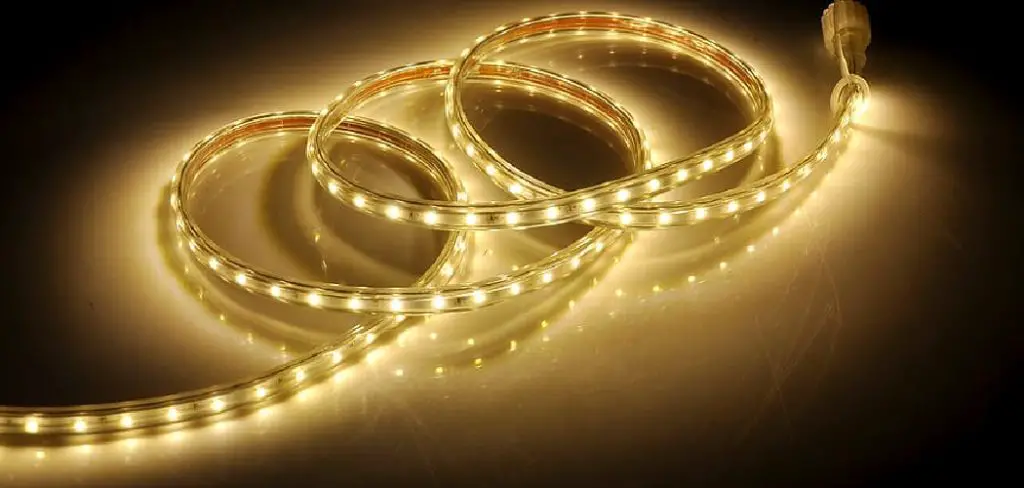Creating brown LED lights involves combining different colors of light to achieve the desired warm, earthy tone. Unlike primary colors, brown is a complex color that requires a careful balance of red, green, and blue light. By adjusting the intensity of

these colors, you can produce various shades of brown to suit different purposes, whether for decorative lighting, artistic projects, or practical applications. This guide will walk you through the step by step process of how to make brown led lights, ensuring you can create brown LED lights with precision and ease.
Why Brown LED Lights Are Uncommon
Brown LED lights are uncommon primarily because brown is not a spectral color, meaning it cannot be produced by a single wavelength of light like primary colors. Instead, brown must be created by mixing multiple colors of light with specific intensities, such as lowering the brightness of red and blending it with green or blue. This requirement makes it technically challenging and less efficient to produce compared to other colors. Additionally, there is limited demand for brown lighting in most industries, as it is not often used for functional lighting or high-visibility applications. Consequently, manufacturers focus on producing LEDs in more popular colors such as white, blue, or warm tones like amber, which have broader utility and appeal.
Understanding LED Light Color Mixing
LED light color mixing relies on the principles of additive color mixing, where different colors of light are combined to produce new colors. The primary colors of light—red, green, and blue—form the foundation of this process. By adjusting the intensity of each primary color, a wide spectrum of colors can be created, including secondary and tertiary colors. For example, combining red and green light in equal amounts produces yellow, while mixing green and blue creates cyan.
To achieve precise colors, LEDs are controlled using dimming techniques such as pulse-width modulation (PWM), which adjusts the brightness of each color channel independently. Understanding the interplay between color intensity and brightness is crucial for creating specific hues, including complex ones like brown. The key lies in carefully calibrating the red, green, and blue channels to achieve the desired tone without oversaturating or distorting the output.
10 Methods How to Make Brown Led Lights
1. Understanding the Science of LED Colors
Before attempting to create brown LED lighting, it’s essential to understand how LEDs produce colors. Unlike traditional light sources, LEDs emit light at specific

wavelengths rather than blending broad-spectrum light. Since brown is not a spectral color, it must be simulated using color mixing techniques, filters, or dimming methods.
2. Using RGB LED Strips and Controllers
One of the most effective ways to achieve a brown-like hue is by using an RGB LED strip and adjusting the red, green, and blue (RGB) channels. By setting a high red value, a low green value, and a moderate blue value, you can create a color that closely resembles brown. Experiment with different intensity levels to fine-tune the shade to your preference.
3. Combining Red and Green LEDs with Dimming Control
Since brown is a dark, muted color, mixing red and green light at lower brightness levels can create a brownish effect. By using an LED dimmer or a programmable microcontroller like an Arduino, you can carefully balance the intensity of red and green LEDs while minimizing blue light to achieve a brownish tone.
4. Applying Color Filters or Gels
Another simple way to produce brown light is by using a color filter or gel over an existing LED light. A warm orange or amber filter over a red LED can shift its hue towards brown. The choice of filter depends on the exact shade of brown you are aiming for, so experimenting with different color gels can help refine the result.
5. Mixing Warm White LEDs with Colored LEDs
Warm white LEDs, which have a slightly yellow or amber tone, can be blended with dimmed red or orange LEDs to create a brownish effect. Placing warm white LEDs in close proximity to adjustable RGB LEDs allows for a natural blending of colors that can result in a brownish illumination.
6. Using Smart LED Bulbs with Customizable Color Settings
Smart LED bulbs, such as Philips Hue or LIFX, provide a broad range of color options through app-based controls. By adjusting the hue and saturation settings, you can create a custom brown shade. Some smart bulbs allow precise RGB or CMYK input, making it easier to fine-tune a brown tone by adjusting color proportions.
7. Layering LED Colors in a Diffuser or Light Box
Placing multiple colored LEDs inside a diffuser or light box can help blend colors more smoothly. A combination of red, green, and warm white LEDs diffused

through a frosted plastic or fabric panel can create a soft brownish glow. This technique is especially useful for ambient lighting or artistic installations.
8. Adjusting Voltage and Current to Influence LED Output
The brightness and perceived color of an LED can be altered by adjusting its voltage and current. Lowering the power supply to red or orange LEDs can sometimes produce a duller, more muted tone that resembles brown. However, this method should be approached with caution to avoid damaging the LED components.
9. Using External Surfaces to Reflect and Blend Light
Reflecting LED light off brown or earth-toned surfaces can create an illusion of brown lighting. By directing warm-colored LEDs toward a brown-painted wall, wood surface, or fabric, the reflected light takes on a brownish appearance. This method works well in decorative or theatrical settings where indirect lighting is used.
10. Experimenting with Color Temperature and Saturation Adjustments
Some LED controllers and software interfaces allow users to adjust color temperature and saturation levels. Lowering the saturation of an orange or amber LED while reducing brightness can create a brownish effect. Testing different configurations with a color-adjustable LED controller will help achieve the best results.
Maintenance and Upkeep
Proper maintenance and upkeep of LED lighting systems are critical for ensuring their longevity and consistent performance. Start by regularly inspecting the LEDs and their fixtures for any signs of damage, such as cracked lenses, loose wiring, or discoloration. Dust and debris can accumulate on the surface of LED lights, reducing their brightness and efficiency, so it’s important to clean them periodically using a soft, lint-free cloth and a non-abrasive cleaner.

Additionally, ensure that the power supply and control systems are functioning correctly. Over time, components like dimmers, drivers, and controllers can degrade or become misaligned, which may affect the color output or brightness. Checking for stable connections and proper voltage levels can prevent premature failures.
If the LEDs are part of an outdoor setup, it’s essential to assess their weatherproofing. Look for any signs of water ingress or corrosion around the fixtures and replace seals or housings as needed. Regular maintenance also includes updating firmware for smart LED systems to enhance functionality and address potential software issues. By following these steps, you can maximize the efficiency, durability, and aesthetic quality of your LED lighting setup.
Troubleshooting Common Issues
When working with LED lighting systems, encountering issues is not uncommon. Below are some of the most common problems and solutions to help you troubleshoot effectively:
1. LEDs Not Turning On
- Cause: This is often due to a loose or faulty connection, incorrect power supply, or damaged LEDs.
- Solution: Check all wiring and connections to ensure they are secure. Verify that the power supply matches the voltage and current requirements of the LEDs. If individual LEDs are damaged, they may need replacement.
2. Flickering or Flashing LEDs
- Cause: Flickering can be caused by an unstable power supply, incompatible dimmers, or insufficient driver capacity.

- Solution: Test the power source to ensure it provides a consistent and stable output. If using dimmers, confirm they are compatible with your LED setup. Upgrading to a higher-quality LED driver may resolve the issue.
3. Incorrect Color Output
- Cause: Over time, colors may shift due to aging components, incorrect controller settings, or calibration issues.
- Solution: Check the LED controller or software settings and recalibrate the color output if necessary. Replace any worn or degraded components that may be affecting color accuracy.
4. Overheating LEDs
- Cause: Poor ventilation, insufficient heat dissipation, or using LEDs beyond their specified power range can cause overheating.
- Solution: Ensure proper airflow around the LED fixtures and verify that heat sinks or cooling mechanisms are intact. Lower the power supply level if it exceeds the recommended range.
5. Uneven Brightness Across LEDs
- Cause: This issue is commonly caused by uneven power distribution, faulty wiring, or LEDs of differing qualities.
- Solution: Check wiring for proper connections and equal distribution of power. If the LEDs are mismatched, consider replacing them with a consistent batch for uniform performance.
6. LEDs Dimming Unexpectedly
- Cause: Voltage drops in long runs of wiring, insufficient power supply, or overheating can cause LEDs to dim over time.
- Solution: Use shorter wiring runs or higher-gauge wires to reduce voltage drops. Verify that the power supply can adequately handle the load and check for overheating issues.
Conclusion
While brown is not a naturally emitted color in the LED spectrum, these ten methods offer various ways to achieve a brown lighting effect. Whether through RGB mixing, filters, smart bulbs, or reflective techniques, there are multiple creative approaches to crafting the perfect brown LED illumination for your project. Thanks for reading, and we hope this has given you some inspiration on how to make brown led lights!


It’s great that you are getting ideas from this article as well as from our argument made at this time.